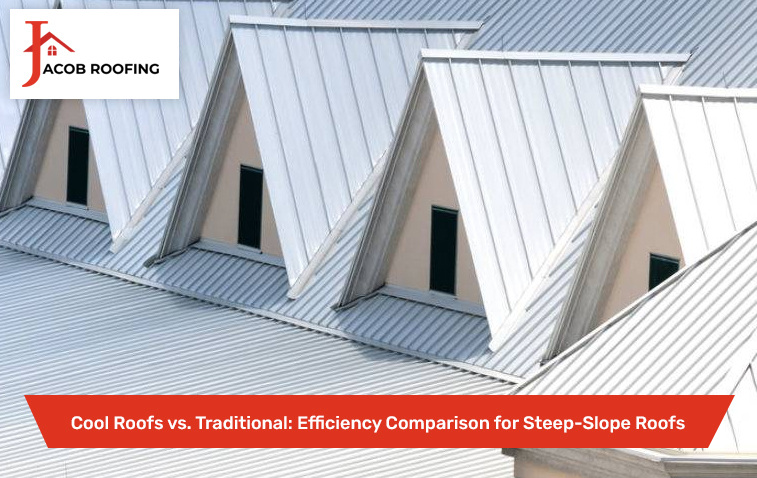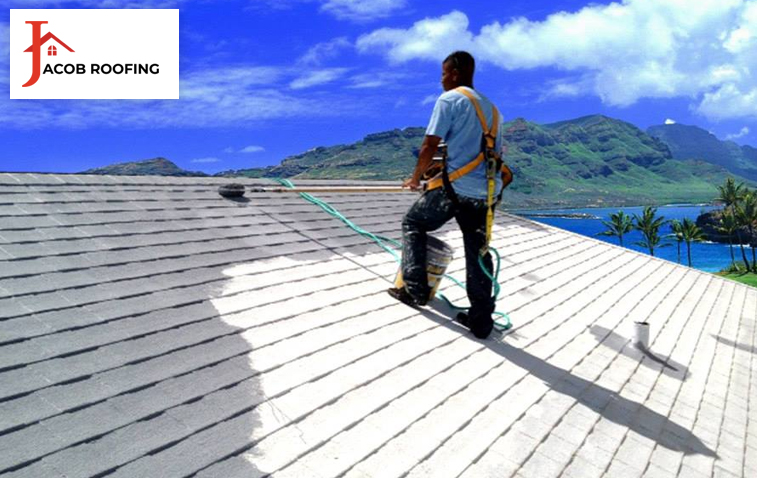Cool Roofs vs. Traditional: Efficiency Comparison for Steep-Slope Roofs
Steep sloping roofs are very common in American homes. Be it in urban areas or rural areas, these roofs play a vital role in keeping the house cool and protecting it from rain. But have you ever wondered how the design and material of your roof affects the energy efficiency of your home?
There are two major types of roofs – cool roof and traditional roof. The difference between the two is not just in appearance but also has a major impact on the temperature control and energy consumption of your home. Traditional roofs generally absorb more heat, while cool roofs are made of materials that reflect heat.
Nowadays people are turning to cool roofs to avoid heat and reduce electricity consumption. For steep sloping roofs, it is important to know which roof is best for your home. Choosing the right roof can not only keep your home cool but also reduce your electricity bills. We will compare cool roofs vs. traditional roofs to help you understand which option is best suited for your steep roof.

What is a cool roof?
Cool roofs are roofs whose surface is designed to reflect the sun’s heat. This process keeps the roof temperature low and the indoor environment cool.
Helps in temperature control
The specialty of cool roofs is that they prevent the roof surface from heating up. Due to this, the direct rays of the sun are reflected, which reduces the temperature of the roof. These roofs are usually of light colors, which reflect back the heat instead of absorbing it. Light colored roofs are much cooler than traditional black or dark colored roofs. This process not only keeps the inside of the house cool but also reduces dependence on air conditioners.
Reduced energy consumption
When the home is cool, the use of air conditioners is reduced, which reduces electricity consumption. Cool roofs have a much better energy efficiency, which reduces the overall energy consumption of the home and has a positive impact on the environment. Additionally, energy savings also provide long-term benefits for the home. The cooling effect also makes your home appliances last longer and keeps the home cool. This is especially effective in hot climate areas.
Long-term durability
Cool roofs not only save energy, but they are also durable. Its material does not get damaged by the sun’s rays, which increases its lifespan. Long-lasting cool roofs save you from having to replace the roof frequently. Its durability makes cool roofs better than traditional roofs. These roofs are able to withstand changes in the weather. This reduces the need for repairs and maintenance in the long run, which also reduces costs.
Traditional Roofs: Common Options
Traditional roofs are usually made of black or dark coloured tiles or sheets. These roofs absorb the sun’s heat and transmit it inside the house, raising the temperature of the house.
Summer Impact
Traditional roofs absorb the sun’s rays and this raises the temperature of the roof a lot. This heat then goes inside the house, making the indoor environment hot. This makes the air conditioner work harder, which increases energy consumption. Absorbing heat for a long time makes the heat inside the house unbearable, causing a lot of discomfort to the occupants in the summer. This not only increases electricity consumption, but also weakens the roofing material over time.
Winter Benefits
Although traditional roofs absorb more heat in summer, they also provide benefits in winter. During the winter season, when the heat of the sun is needed, these roofs help keep the house warm by trapping the heat inside. Therefore, traditional roofs can be effective in cold areas. These roofs keep the house naturally warm in winter, reducing the need for heating. If you live in a cold area, traditional roofs can help save energy. However, they are not as effective in summer.
Durability and maintenance
Traditional roofs require periodic maintenance, as they are easily damaged by heat and other weather effects. They have a shorter lifespan than cool roofs, and may require frequent repairs. Because they absorb heat, their temperature is very high, which causes the material to deteriorate quickly. This requires frequent maintenance and increases costs. These roofs can also be affected more quickly by rain, snow or hail, requiring additional repair costs.
Comparison between Cool Roofs and Traditional Roofs
Heat Protection
Cool roofs are more effective in summers as they reflect heat and keep the house cool. On the other hand, traditional roofs absorb heat, which raises the temperature of the house and increases the need for air conditioning. Cool roofs have a greater cooling effect and these roofs stay cool throughout the day. Traditional roofs absorb more heat during the afternoon, which remains inside the house till night.
Energy Efficiency
Cool roofs help in increasing the energy efficiency of the house. It reduces the use of air conditioners in summers, which reduces electricity consumption. On the other hand, traditional roofs have low energy efficiency, especially in the summer season. Traditional roofs consume more energy and have a negative impact on the environment. On the other hand, the use of cool roofs is environmentally friendly, which reduces the energy use of the house.
Long-term benefits
Cool roofs are more durable in the long term as they are not damaged by the sun’s rays. Traditional roofs require frequent repairs, which increases the overall cost. Cool roofs are more beneficial in terms of durability. The material of traditional roofs weakens over time, while cool roofs can last for many years without any major repairs. This saves you from spending on frequent repairs.
Winter performance
Cool roofs provide a feeling of coolness in winter, while traditional roofs help trap heat inside. Therefore, traditional roofs may be better in cold areas, but their performance is weak in summer. During winter, the use of cool roofs is not very effective as it is unable to keep the cold out. On the other hand, traditional roofs keep the temperature inside the house balanced in winter and provide natural heat.
Effect on the environment
Cool roofs not only increase the energy efficiency of the house, but it is also better for the environment. It helps in reducing global warming by reducing heat. On the other hand, traditional roofs increase heat and can have a negative impact on the environment.
Pollution reduction
Cool roofs reduce energy consumption, which also reduces pollution. Less energy use means fewer greenhouse gases are emitted, which is good for the environment. In contrast, traditional roofs consume more energy and therefore put more pressure on the environment. Using a cool roof also reduces the carbon footprint of your home. It is an environmentally friendly method that has long-term benefits.
Temperature control
In cities, the use of cool roofs can reduce the “heat island effect”, where the temperature of cities rises due to the heat of buildings and roads. Cool roofs help reduce this effect and control the temperature of the city. They are especially beneficial in large urban areas, where there is a high temperature rise during summers. Using cool roofs in cities can reduce temperatures overall.
Sustainable construction
The sustainable construction of cool roofs and the use of eco-friendly materials make it a better option. Not only does this reduce the energy consumption of your home, but the roof also lasts longer. Due to its durable construction, these roofs are also protected from the adverse effects of the weather. Compared to traditional roofs, cool roofs have a longer lifespan and lead to long-term energy savings.

How to Choose the Right Roof?
There are a few things to keep in mind while choosing the right roof for your home. Firstly, it is important to see the climate in which your home is located. Cool roofs are better in warmer regions, while traditional roofs can be used in colder regions.
Climate and Weather
If you live in an area where the heat is high, a cool roof may be a better choice for your home. It will not only keep the house cool but also reduce energy consumption. In colder regions, where the sun’s heat is needed in winters, traditional roofs can be used. Therefore, it is essential to choose a roof keeping in mind the weather conditions. This will give you energy savings and comfort in the long term.
Long-term needs
You should also think about what your long-term needs are. Are you focused on saving energy, or keeping the house warm in the winter? Your needs will determine which roof is right for you. If you want a long-term, sustainable solution, a cool roof may be more beneficial. On the other hand, traditional roofs are advisable in areas with cold winters.
Choosing the right roof for a steep slope is crucial for your home’s energy efficiency and comfort, particularly in the context of cool roofs vs. traditional roofs. Both cool roofs and traditional roofs have their pros and cons. While cool roofs make the house cool and energy efficient in the summer, traditional roofs help retain heat in the winter. The right choice for your home will depend on your climate, needs, and long-term goals. By making a wise decision, you will not only keep your home comfortable, but also save energy.
